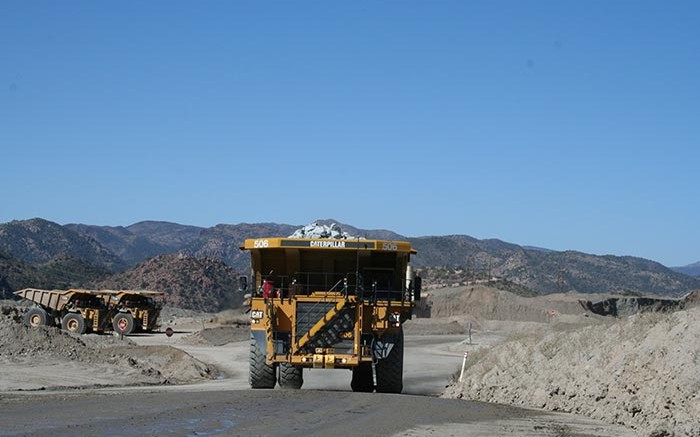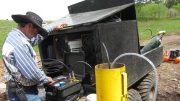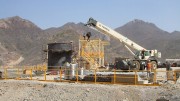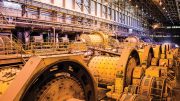Canadian junior companies have a large presence south of the border. The Northern Miner presents its top-10 list of the biggest Canada-based juniors with substantial assets in the U.S., by market capitalization:
1. ARIZONA MINING
Market cap: US$1.47 billion

Don Taylor (left), Arizona Mining COO, and Jerry Willis, senior contract geologist, with core samples at the Hermosa zinc-lead-silver project, 80 km southeast of Tucson, Arizona. Credit: Arizona Mining.
Arizona Mining (TSX: AZ; US-OTC: WLDVF) tops our list this year, but that won’t happen next year. That’s because South32 (LON: S32; ASX: S32) is acquiring the remaining 83% of Arizona’s shares it doesn;t already own in a deal valued at US$1.3 billion. Arizona Mining says the deal gives the company a total equity value of US$1.6 billion.
South32 offered to acquire the company at $6.20 per share, in a 50% premium to the price on June 15, 2018. After the announcement, shares of Arizona Mining shot up above $6.10 a-piece. At press time it traded at $6.20.
Arizona’s flagship Hermosa zinc project is located 80 km southeast of Tucson, Arizona. It contains 101 million measured and indicated tonnes grading 10.4% zinc equivalent. It remains open in several directions.
2. NOVAGOLD RESOURCES
Market cap: US$1.4 billion

Making progress on road construction to the Galore Creek project in B.C. in 2008. Credit: NovaGold Resources.
NovaGold Resources (TSX: NG; NYSE-AM: NG) recently sold its 50% stake in the Galore Creek gold project in northern B.C. in a deal that could net the company as much as US$275 million.
Upon closing the deal, Newmont Mining (NYSE: NEM) will pay NovaGold US$100 million. The remaining US$175 million is broken into three staged payments and contingent on Newmont meeting certain milestones: a prefeasibility study, a feasibility study and project construction. Newmont has committed to completing the prefeasibility study over the next four years. Galore Creek is now a joint-venture between Newmont and Teck Resources (TSX: TECK.A; NYSE: TECK).
NovaGold can now focus solely on its interest in the large but remote Donlin Gold project in southwestern Alaska, which is a 50-50 joint venture with Barrick Gold (TSX: ABX; NYSE: ABX).
Donlin Gold is one of the world’s largest, undeveloped gold deposits, with measured and indicated resources of 541 million tonnes grading 2.2 grams gold per tonne for 39 million contained oz. gold, plus 92 million inferred tonnes grading 2 grams gold.
3. SSR MINING
Market cap: US$1.24 billion

Pit operations at SSR Mining’s Marigold gold mine in Nevada. Credit: SSR Mining.
SSR Mining (TSX: SSRM) recently updated the mine plan for its Marigold gold mine in Nevada, incorporating a sustained mining rate from additional haul trucks it added in 2016, 2017 and 2018 mineral reserves. It says the project is set up for at least 10 more years of mining.
The company predicts Marigold could produce more than 265,000 oz. gold in 2021 and 2022 — a 30% increase over 2017 production. SSR predicts Marigold will produce 218,000 oz. gold in 2019 and 2020, but will average 236,000 oz. gold over the next six years.
The mine has been in production for 29 years. It opened in 1989 with an initial eight-year mine life.
4. MCEWEN MINING
Market cap: US$786 million

McEwen Mining’s silver-gold El Gallo mine in Mexico’s Sinaloa State, in 2016. Credit: McEwen Mining.
McEwen Mining (TSX: MUX; NYSE: MUX) has hired Chris Stewart as its president and CEO to replace Xavier Ochoa, who resigned in July.
The firm has closed a US$50 million senior-secured three-year term loan, with the funds earmarked for completion of construction at its new Gold Bar gold mine in Nevada, and for general purposes.
Rob McEwen — McEwen Mining’s chairman and self-described “chief owner,” with 24% of the firm’s 337 million outstanding shares — is participating as lender for half of the US$50-million loan.
McEwen’s principal assets consist of: the San Jose mine in Santa Cruz, Argentina (49% interest); the Black Fox mine in Timmins, Ontario; the El Gallo Fenix project in Mexico; the Gold Bar mine in Nevada, currently under construction; and the large Los Azules copper project in Argentina, advancing towards development.
5. NEW GOLD
Market cap: US$726 million

New Gold’s Rainy River gold mine under construction, 65 km north of Fort Frances, Ontario. Credit: New Gold.
In May New Gold (TSX: NGD; NYSE-AM: NGD) appointed Raymond Threlkeld as its new president and CEO, replacing Hannes Portmann. Threlkeld has been on New Gold’s board since 2009.
New Gold’s sole operating mine in the U.S. is its Mesquite gold mine in southeastern California’s Imperial Couty, 70 km northwest of Yuma, Arizona.
Owned 100% by New Gold, the former producer was restarted in January 2018 and in recent years has produced well in excess of 100,000 oz. gold annually.
Reserves at Mesquite tally 1.5 million oz. gold, with resources of 800,000 oz. gold.
6. GOLD STANDARD VENTURES
Market cap: US$429 million

Looking north at a drill rig on Gold Standard Ventures’ Dark Star gold deposit in Nevada. Credit: Gold Standard Ventures.
Gold Standard Ventures (TSX: GSV; NYSE-AM: GSV) is drilling its Railroad–Pinion gold project in Nevada’s Carlin trend. The company recently reported results from 31 reverse-circulation holes and two core holes at the project’s Dark Star deposit. To date the deposit has received nearly 20,000 metres of infill, step-out and geotechnical drilling across 121 holes. The current drilling confirms the system remains open to the north, west and at depth.
Highlights include: 10.7 metres from 123 metres downhole at 3.04 grams gold and 24.4 metres from 145 metres downhole grading 3.36 grams gold.
The company also drilled 28 holes in the project’s Jasperoid Wash deposit, 7.5 km southwest of Dark Star. Highlights include: 4.6 metres from 54 metres downhole at 1.56 grams gold and 9.1 metres from 183 metres downhole at 1.01 grams gold.
7. PREMIER GOLD MINES
Market cap: US$396 million

A shovel loads a haul truck at Premier Gold Mines and Barrick Gold’s South Arturo gold mine in Nevada. Credit: Premier Gold Mines.
Premier Gold Mines (TSX: PG; US-OTC: PIRGF) recently tabled a preliminary economic assessment for its Cove gold-silver project in Nevada. According to the study, the project has a $142-million, after-tax net present value at a 5% discount rate and a 48% after-tax internal rate of return. The project could produce 92,000 oz. gold per year over eight years and average recoveries of 82.7% for gold and 21.6% for silver.
The company is drilling 40,000 metres at its Mercedes gold mine in Mexico as it tries to expand the main gold bearing horizon and test new areas on the property. Underground drilling at the mine’s Rey de Oro deposit has already extended the deposit’s high-grade vein system.
8. EQUINOX GOLD
Market cap: US$341 million

An aerial view of the mill area under construction at Equinox Gold’s Aurizona gold project in Brazil. Credit: Equinox Gold.
In early August, Equinox Gold (TSXV: EQX; US-OTC: EQXFF) spun out its copper assets into Solaris Copper, and now owns 40% of the newly formed company. Equinox shareholders own the remaining 60% of Solaris.
Equinox is focused on bringing its Aurizona gold mine in Brazil and Castle Mountain gold mine in California into production. As a result of the asset transfer, Equinox began trading under new symbols on the TSX Venture Exchange and the OTC Market in the United States.
The company has begun stockpiling ore at Aurizona. It’s installing semiautogenous grinding and ball mills, and says construction is 60% complete. The US$146-million, pre-production budget is fully funded. So far, the company has spent US$64 million.
9. CAPSTONE MINING
Market cap: US$292 million

Capstone’s mill at Cozamin in Mexico. Credit: Capstone Mining.
Capstone Mining’s (TSX: CS) chief asset in the U.S. is its Pinto Valley open pit copper-molybdenum-silver mine and associated mill, located 125 km east of Phoenix, Arizona.
The mill thoughput was 53,850 tonnes per day in 2017, producing 57,300 tonnes of copper.
There are at least 21 years of mine life left and the operations employ 651 people, including contract employees.
The company produced 16,336 tonnes payable copper across all its operations in 2018’s second quarter, down from 18,914 tonnes the year before. It generated US$28.8 million in cash flow in the quarter, up from US$4.1 million the year before.
10. POLYMET MINING
Market cap: US$252 million

Polymet’s Northmet project in Minnesota. Credit: Polymet Mining.
Polymet Mining (TSX: POM; NYSE-AM: PLM) moved one step closer to developing its flagship Northmet polymetallic mine in Minnesota when it acquired another 26.9 sq. km around its orebody from the U.S. Forest Service in June.
In exchange for the land, Polymet transferred 27 sq. km back to the Forest Service that it will add to the Superior National Forest in northeast Minnesota. Polymet’s land holdings now total 76.8 contiguous square kilometres.
As of a 2013 feasibility study, Northmet has a US$271-million, after-tax net present value at a 7% discount rate and a 10.3% after-tax internal rate of return. The project contains 254 million proven and probable tonnes grading 0.29% copper, 0.08% nickel, 80 parts per billion platinum, 268 parts per billion palladium, 39 parts per billion gold, 74.42 parts per million cobalt and 1.06 parts per million silver.






Be the first to comment on "Top 10 Canada-based juniors with substantial assets in the US"